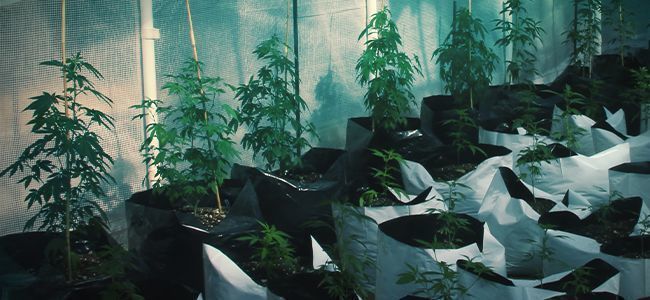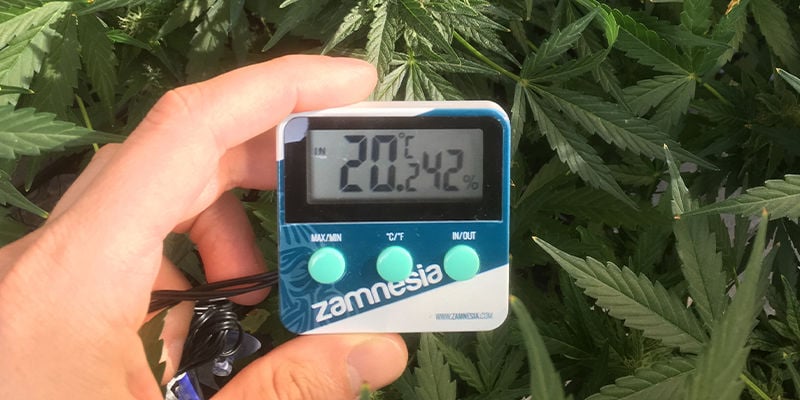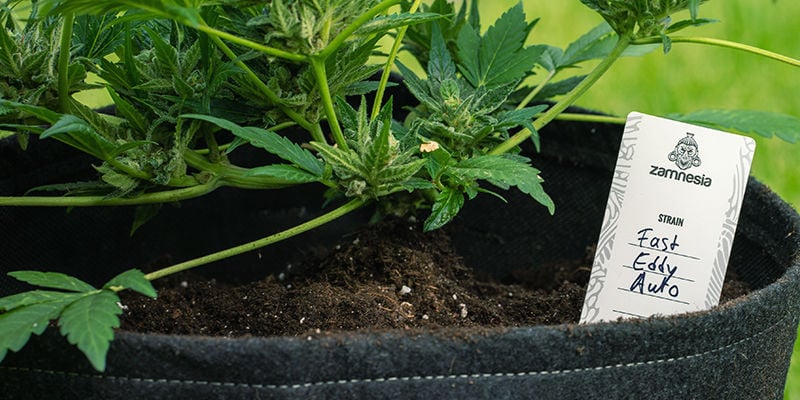
What Is A Smart Pot And How To Make Your Own
Smart pots can enhance overall marijuana health and vitality. Understanding how they work will help you make a decision on whether to use smart pots or regular containers. Zamnesia shows you how to make your own smart pot to produce world-class weed.
Smart pots have been used in the nursery industry since the 1980s. They are a favourite among tree farmers in many countries of the world. More recently, using smart pots for growing cannabis is gaining a lot of fans. Outdoor growers especially are finding benefits when using smart pots over plastic containers. Overall plant vigour is continuous from seed to flower, and the threat of root pathogens is minimised. Understanding how they work can help you make important decisions regarding the root health of your grow.
WHAT'S A SMART POT?

Smart pots are plant-growing vessels made from heavy-duty, porous industrial cloth. The material breathes and allows air into the growing medium from the edge of the pots. This significant difference from plastic pots is what makes smart pots smart. As the plants grow and the roots reach the edge of the pot, they encounter a film of aerated soil.
Roots are then air trimmed before they can reach the wall of the pot. The apically dominant root tip dehydrates, making the root branch. This in turn encourages more feathering of roots, which increases overall root surface area. This prevents roots from circling the wall of the pot and knitting together, which increases the possibility of root rot. Smart pots promote denser root growth in the body of the root ball where water and nutrient uptake is more efficient.
SMART POTS: BEAT THE HEAT

Smart pots release heat where traditional plastic pots retain heat. Retained heat promotes the flourishing of organisms that cause root rot. Heat also acts as an incubator for a number of soil-borne pests. The horror of root aphids and other difficult-to-control pests is amplified in warm, moist conditions. Like in a plastic pot.
Retained heat also inhibits plant growth. The temperature of summer soil in plastic pots can exceed 35°C. Roots simply won’t grow in that type of heat. Smart pots breathe and dissipate heat into the ground on which they are sitting. The root ball maintains a more stable temperature, and plants are less prone to heat stress.
IT'S ALL ABOUT THE ROOTS
Healthy roots mean healthy plants. A number of disorders can arise when roots aren’t given enough room to expand. Plants potted up from smart pots to larger vessels or the ground experience less transplant shock and grow more vigorously. There are more root tips to penetrate into the new medium, which means more root mass and greater plant stability. More root mass also means bigger plants.
Roots that have spiralled around plastic pots are less likely to penetrate into the new medium. New leader shoots that form space-efficient dendritic root patterns are also less likely to develop due to strangulation. This inhibits water and nutrient uptake because of less surface area, diminishing end yields. Plants can also be very unstable as they don’t “grip” the new medium.
TO GROUND OR NOT TO GROUND?
Cannabis is a hardy plant and will grow wherever there is water and sunshine. However, growing in clay or sandy soil will not bear the results or massive yields demanded by the modern weed fan. Amending soils and building a good soil profile can take a number of years, and can be difficult work. Extensive gardening knowledge is required when modifying native soils to be particularly cannabis-friendly.
Even digging a generous hole to replace the native soil with a custom soil is challenging. This usually requires a mechanical digger or a lot of back-breaking shovelling. If you plan on growing sativa trees this season, that’s many, many cubic metres of dirt to shift.
Smart pots allow for full customisation of the grow medium with far less effort than modifying a patch of soil. The advantage smart pots provide is being outside and filled with a cannabis-friendly medium, without having to till a single sod. Filling a series of smaller pots or one large pot can be as labour-intensive as you please.
Renters who enjoy growing weed will not want to dig up the yards of their rental. Smart pots can be dismantled and removed, along with the soil at the end of a tenancy.
BUY OR MAKE YOUR OWN SMART POT?

Store-bought smart pots are manufactured in a number of different capacities, from only a few litres with handy carry handles, up to mega pots of four cubic metres. They are not reinforced, and sometimes require staking or a wire frame to prevent the larger bags from slipping. They are hard to fault, but may prove a bit expensive for a multi-plant grow-op.
Making your own smart pot can halve costs. The materials are readily available, and a fully functioning smart pot can be customised for your space. They work exactly the same as store-bought pots, and don’t take up too much of your time to construct.
HOW TO MAKE YOUR OWN SMART POT
What You Will Need
- Lightweight wire netting like chicken wire or hardware cloth. Rolls are available in different widths.
- Heavier 10-gauge wire mesh with 75mm spacing or similar (goat or sheep fencing). This wire will support the walls of the pot, so it must have some rigidity.
- Landscape fabric. This comes in different widths and is smooth on one side and fuzzy on the other. Face the fuzzy side inwards.
Put on your math helmet and calculate the materials required. Or, just use the handy list at the end of this text. Volumes are for soil in a pot 50cm deep.
Instructions
-
Roll out a length of heavy-gauge wire to suit chosen pot size. Join the ends together and place on the ground to form a nice cylindrical fence.
-
Place the fine mesh on the ground inside the circle to form the bottom. You can cut it into a circle or just fold the extra edges up. It should cover the entire bottom. This mesh stops burrowing creatures and allows root penetration into the native soil.
-
Unroll landscape fabric and drape along the inside walls of the heavy-gauge wire fence so they are completely covered. Cut it wide enough to leave a fold at the bottom and an edge for fixing at the top. The bottom of your smart pot where the fine mesh is located should remain uncovered.
-
Fix fabric to wire around the top edge. Wire twist ties or bits snipped from the fence wire should hold the fabric well.
-
When filling, fill the edges first to provide stability and rigidity to the wire frame. Go gently and don’t buckle the wire, just place the dirt in position. Once the sides are stable, fill like crazy.
-
Grow weed! To see a more detailed, visual representation of these instructions, check out this 5-minute video.
LOTS OF BUDS WITH A SMART POT
Smart pots are a growing solution that fits the bill for the cannabis grower. They provide a number of advantages over growing in plastic pots or in the ground. Store-bought or homemade, they promote overall plant health and pay themselves back with multitudes of colas to delight any cannabis farmer.
HANDY NUMBERS LIST: MAKING YOUR OWN SMART POT
1m diameter
- Area: 0.8m²
- Circumference: 3.15m
- Volume: 0.4m³
2m diameter
- Area: 3.14m²
- Circumference: 6.3m
- Volume: 1.6m³
3m diameter
- Area: 7.1m²
- Circumference: 9.45m
- Volume: 3.5m³
4m diameter
- Area: 12.6m²
- Circumference: 22.57m
- Volume: 6.3m³
-
 7 min
9 March 2021
The Best Outdoor Cannabis Seeds Per Climate In Europe
We've put together a guide on the best cannabis strains for outdoor cultivation based on different climate zones in Europe. Find out which ones suit your climate below!
7 min
9 March 2021
The Best Outdoor Cannabis Seeds Per Climate In Europe
We've put together a guide on the best cannabis strains for outdoor cultivation based on different climate zones in Europe. Find out which ones suit your climate below!
-
 5 min
20 May 2019
Top 10 Autoflowering Outdoor Strains
Autoflowering cannabis has a lot to offer, and with the growing season rapidly approaching, we have put together a list of our top 10.
5 min
20 May 2019
Top 10 Autoflowering Outdoor Strains
Autoflowering cannabis has a lot to offer, and with the growing season rapidly approaching, we have put together a list of our top 10.
-
 7 min
28 February 2019
Companion Plants To Nurture & Protect Your Cannabis Crop
Cannabis growers need to plan carefully. This includes placing companion plants strategically around the grow. Used both for outdoor and indoor cultivation, these plants can increase yield by...
7 min
28 February 2019
Companion Plants To Nurture & Protect Your Cannabis Crop
Cannabis growers need to plan carefully. This includes placing companion plants strategically around the grow. Used both for outdoor and indoor cultivation, these plants can increase yield by...
-
 3 min
27 November 2015
Growing Cannabis Outdoors: The Ground Vs Pots
Ground or pots? It is a question on many novice outdoor growers mind. It is all about suiting your needs, so here are the advantages and disadvantages of each.
3 min
27 November 2015
Growing Cannabis Outdoors: The Ground Vs Pots
Ground or pots? It is a question on many novice outdoor growers mind. It is all about suiting your needs, so here are the advantages and disadvantages of each.













 United States
United States












